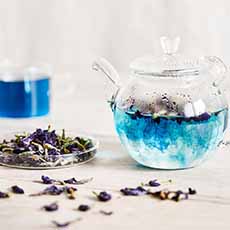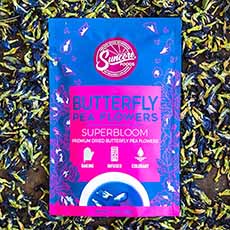TIP OF THE DAY: Make Blue Rice With The Butterfly Pea Flower
|
This blue rice (photo #1) is made by steeping the water with the butterfly pea flower, which colors it naturally. The flower is used to brew herbal tea in Thailand, just by steeping the dried blue pea flowers in water. Here’s more about and how to use the butterfly pea to make blue and purple tea. The flowers are also used as a natural food dye in Southeast Asian dishes, particularly in Malaysia and Thailand. Rice is the most common food to get colored blue. Nasi kerabu is a Malaysian cuisine rice dish in which blue-colored rice is eaten with dried fish or fried chicken, crackers, pickles and other salads: a feast! As a bonus, the butterfly pea flower is packed with health-promoting antioxidants. Since the flower steeps in water, milk or other liquid, it can add color to other foods. Beyond rice, how about pasta? How about some blue rice pudding with golden and purple raisins, or a blue cream pie? Blue vodka? Why not sweeten the blue tea and freeze it for ice pops. But then…why not just use McCormick blue food coloring? You certainly can; but not if you want to avoid artificial chemicals. The color obtained from the butterfly pea flower is totally natural. But there’s another way to naturally color your food. If you’re seeking to avoid the artificial dyes in the big commercial food colors, The Watkins Co. makes an all-natural food colorings. The colors are derived from pure vegetable juices and spices, including beet juice, turmeric and spirulina extract. This is a simple recipe to make blue rice. In Asia, lemongrass is typically added for more flavor. Here’s a recipe with lemongrass and kaffir lime leaves. The dried butterfly pea flowers are available on Amazon and at some Asian markets, as is lemongrass powder and dried kaffir lime leaves. Ingredients **The typical water:white rice ratio is 2 cups water to 1 cup rice. 1. BOIL the water. Add the butterfly pea flowers and wait for a few minutes till the color turned dark blue. Usually, the flowers will lose their color in the process. Don’t worry if the water is too dark. The cooked rice will be a lighter color. You can squeeze the flowers to extract the remaining color. 2. STRAIN or otherwise remove the flowers from the water. 3. WASH the rice and drain, 4. COOK in the butterfly pea water, according to your own rice-cooking technique. It’s he flower of the plant commonly known as blue pea or butterfly pea. It is also known as Asian pigeonwings, bluebell vine, blue pea, butterfly pea, cordofan pea and Darwin pea [source]. The plant is native to tropical equatorial Asia, including locations such as India, Indonesia, Malaysia, Myanmar, Thailand and the Philippines. The bright blue flower is used as a natural coloring in various recipes. It is one of the most vivid blue colors to exist in nature. The plant species belongs to the Fabaceae family, commonly known as the legume, pea, or bean family. The family includes such familiar foods as beans, carob, chickpeas, licorice, peanuts and peas. Now for the racy part: The botanical name of the butterfly pea plant is Clitoria ternatea. The botanist who named saw that the flower had the shape of female genitalia, and gave the genus the Latin name Clitoria, from clitoris (photo #7). You can see why others call it the butterfly pea plant. |
|
|
|
|
||






